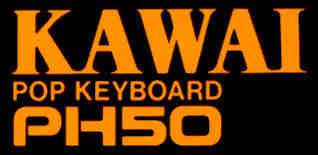
 |
(sample based MIDI keyboard with great movie effect & synth sounds) |
This is an almost plain ordinary fullsize keyboard with MIDI, 200 preset wavetable sounds and 30 rhythms. The sounds are made from medium resolution samples and many have a nicely grainy digital lo-fi appeal. The great thing of this instrument is that (like with the Casio SA-series) its sound bank is in no way GM compatible but instead includes tons of unusual (partly algorithmic) effect sounds. These include beside normal instrument timbres many of the typical modern, sample based hollywood horror and SF movie sound effects with much reverb, breathy atmospheric timbres and distant roaring or rumbling bass noises; many sounds are even named after movies (partly with intentional misspellings against copyright trouble? - e.g. "terminater", "halloween", "predatory", "poltergeist", "karate kid"). Other sounds were likely named after pop/ rock musicians those I mostly don't know (e.g. "flex solo", "felix solo", "chick solo", "jan's solo", "deep purple"). The sound bank also includes many breathy Fairlight CMI style choirs and nice Hammond organ timbres as well as some percussion stuff.
Despite the preset sounds are designed velocity sensitive (timbre partly changes drastically with velocity), the keys of the instrument aren't. Only by pressing its tiny joystick down, the keyboard can be toggled on/ off between playing either half or maximum velocity notes. This analogue joystick is also used for pitchbend (left & right) and "vibrato" (by holding it up). But this "vibrato" is rather a more general modulation feature, which has very different effects on different sounds (e.g. transforms pianos into honky- tonk pianos, changes the leslie speed of Hammond timbres or distorts e-guitars). Generally the modulation often adds creaky vibrato or strange fluttering chorus vibrato variants, those at high intensity with many sound lovely remind to classic C64 SID sound estheticism. Annoying is that there appears to be no way to play sounds with permanently active modulation (except through MIDI), because the return spring re- centers the joystick automatically and I also found no button to set its default value. (I have no manual for this thing). Despite up to 4 preset sounds can be layered as "combinations" (stored in 50 non- volatile memories), the analogue joystick apparently also can not be used to crossfade among them in the manner of "vector synthesis" known from other joystick keyboards. Strange is also that (except with combination sounds) instead of stereo the left keyboard half always plays strictly through the left speaker, while the right half plays through the right. (Only with those few presets including a key split this makes sense to permit musicians to send each half through a different external effect device.)
Annoying is that instead of one real keyboard drum kit mode there are only many sound presets with each only 2 or 4 percussion sounds distributed over multiple keys (mostly playing the same note pitch). The presets also include a few "1 key beat" drum loops (and some similar sequences), but not even there tempo can be changed despite these are not made from a single sample. Despite there are 30 rhythms (with partly unusual patterns), this thing has no accompaniment (likely there was no ROM space left, thus Kawai replaced it with the 100 additional sounds, since other Kawai home keyboards have only 100 presets). The controls of the instrument are a bit awkward, since you have to step with {"+1", "+10", "-1", "-10"} buttons to enter numbers, and they not even flip around at the end of their value range, thus you have to step all way back to reach sound 1 from sound 200. There are no OBS controls and not even tempo +/- has own buttons.
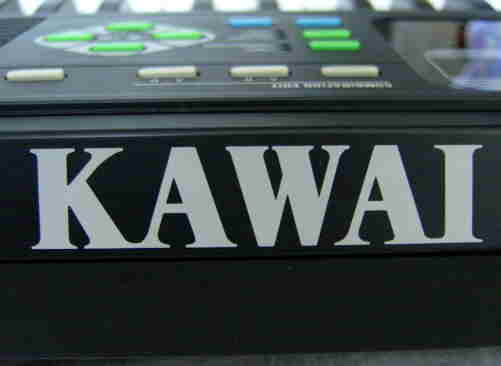 |
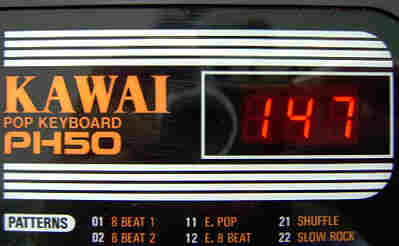 |
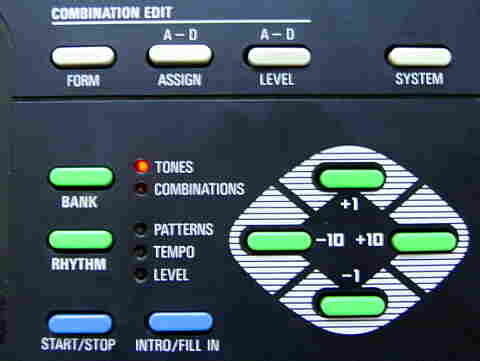 |
 |
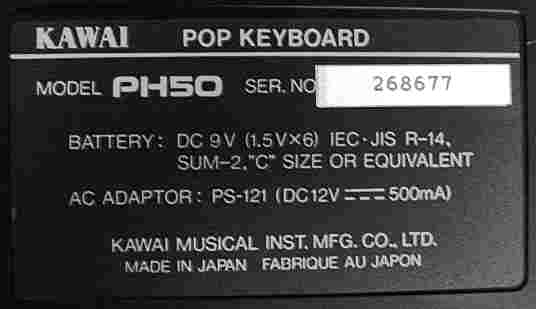 |
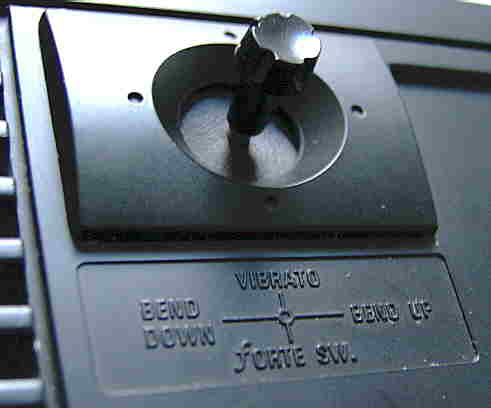 The
tiny protruding analogue joystick of the Kawai PH50 may easily crack
off
or damage other things during transport. Since it can not be uses for "vector
synthesis" (crossfading among timbres), a normal pitch and modulation wheel
would have made much more sense here, since the badly placed joystick can
not be reached during both- handed play. I don't understand why the "vibrato"
(modulation) setting can not be enabled permanently, but stays active only
so long the spring loaded stick is manually held up, despite many presets
sound much better when enabled. (It e.g. adds a rotary speaker simulation
to Hammond timbres.) The dose of the effect can be even proportionally
controlled very fine by the joystick, thus I strictly recommend to add
a potentiometer with a knob here. The velocity otherwise can be only switched
between 2 fixed values (toggled by pushing the joystick down) despite also
here a proportional control would have made sense. Strange is also that
this instrument has only plain rhythms and no accompaniment, and there
is also no demo music. (In opposite to this, e.g. the midsize MIDI keyboard
Kawai
MS720 had a very costly accompaniment.) I am not sure how professional
the PH50 was meant, since the lack of accompaniment and demo may
either stress the professional approach of a special purpose instrument,
but more likely I guess that in the chip there was simply no ROM space
left, thus Kawai omitted accompaniment and demo to fit 200 preset
sounds into this cheaply built instrument, since other Kawai home keyboards
have only a 100 sound bank. At least I think I have heard sounds effects
of the PH50 in various movies, modern videogames and PC software
yet. (I haven't examined the hardware yet.)
The
tiny protruding analogue joystick of the Kawai PH50 may easily crack
off
or damage other things during transport. Since it can not be uses for "vector
synthesis" (crossfading among timbres), a normal pitch and modulation wheel
would have made much more sense here, since the badly placed joystick can
not be reached during both- handed play. I don't understand why the "vibrato"
(modulation) setting can not be enabled permanently, but stays active only
so long the spring loaded stick is manually held up, despite many presets
sound much better when enabled. (It e.g. adds a rotary speaker simulation
to Hammond timbres.) The dose of the effect can be even proportionally
controlled very fine by the joystick, thus I strictly recommend to add
a potentiometer with a knob here. The velocity otherwise can be only switched
between 2 fixed values (toggled by pushing the joystick down) despite also
here a proportional control would have made sense. Strange is also that
this instrument has only plain rhythms and no accompaniment, and there
is also no demo music. (In opposite to this, e.g. the midsize MIDI keyboard
Kawai
MS720 had a very costly accompaniment.) I am not sure how professional
the PH50 was meant, since the lack of accompaniment and demo may
either stress the professional approach of a special purpose instrument,
but more likely I guess that in the chip there was simply no ROM space
left, thus Kawai omitted accompaniment and demo to fit 200 preset
sounds into this cheaply built instrument, since other Kawai home keyboards
have only a 100 sound bank. At least I think I have heard sounds effects
of the PH50 in various movies, modern videogames and PC software
yet. (I haven't examined the hardware yet.)
Kawai calls the synthesis engine "VM" (Variable Memory). The sounds are based on samples of medium resolution, and most of them sound cold and a little rough and thin. But at least they are programmed velocity sensitive and change their timbre depending on the velocity value; e.g. flutes get more breathe noise, other sounds turn brighter or with some effect sounds even turn into something different (I only tried this by joystick and not by MIDI yet) and also the modulation with the joystick gradually modifies the timbres, which makes them at least less static than on most sample based tablehooters. But otherwise the sound style has many things common with the great Casio SA-series, although the PH50 doesn't overuse reverb and echo on normal sounds that extremely. (I don't list all but only some special sounds here.) The acoustic pianos sound a bit grainy since they seem to be made from 2 layered static waveform samples (at least with with 3 split points). The acoustic strings sound (unlike Casio SA keyboards) like from a sampled string orchestra, but fairly rough and noisy. There are also some cold and static synth brass sounds resembling the famous SA-series "brass ens.", and some variants here have a grainy dose of (intentional?) zipper noise in their attack phase (like the Casio SK-1 "trumpet"), which makes them sound a bit like sent through a ring modulator. The "baggy pipe" is a bagpipes that quickly howls up during the attack phase in monophonic play, but doesn't howl when notes are held. The pop and rock organ timbres are also nice. E.g. "speed king" is the typical metallic multipulse squarewave pipe organ imitation, although this one sounds a little harsh. With the nice "drawbar" organ timbres the modulation increases the rotary speaker speed. Some of the "solo ..." timbres can be only played monophonic (likely intended to mix in "combination" sounds). There are also nice sitar and other Asian instrument timbres.
Some presets were likely named after movies or music bands, since their names are partly absurd and don't describe at all how they sound like. E.g. "magical dog" is a key split with a synth clavinet on the left hand and a plain percussive Hammond timbre on the right. But most interesting are the many atmospheric horror/ SF movies sound effects, although these don't include the 1950th/ 60th theremin sound era, but rather modern 1990th hollywood stuff that reminds e.g. to the atmospheric reverbing and droning noises heard in the background tunes of the Tomb Raider videogame. E.g. "dragon hall" is a slowly louder fading, muffled bassy roar with much reverb and breathy hiss (possibly made from a reversed big gong sample). "predatory" is similar but brighter and with high velocity contains additional fading noises at the end. "visitors" is a split sound with hissy droning bass at the left hand, and an atmospheric Fairlight choir layered with a clock chime tone and random synth chirp at the right hand, which sounds much like from a "Poltergeist" movie. "Poltergeist" contains the same breathy choir, which dissolves into a disharmonic ascending chord after a second. "breath" resembles a down sampled hissy mixture of pan flute and choir that fades silent and has much reverb. There are various other variants of such sounds. E.g. "(( BARREL ))" layers such a noise with a drum, "return home" is a down and up howling breathy timbre with much reverb. "halloween" is a split with a disharmonic, louder fading choir at the right and a thunderstorm at the left hand. "from hell" is a bright metallic sound that reminds a droning piano in the bass range and a sitar in the trebles. "slave labour" is a sequence of kettledrums, drums and reversed gongs (all keys same note). "paradox" is a cacophonic up and down howling e-bass pattern loop that starts with a looped reverse cymbal noise and slowly fades silent in the release phase. "arrangement" is a string chime pattern that sounds like from Tomb Raider. "ninja" is a a fast hissing pan flute (and cello??) pattern of 3 notes. "karate kid" is like a noisy hissing pan flute with percussive piano envelope (mixed with kettledrum?).
"amazone" is a synth brass bass which timbre starts distorted (like a slap bass) and fades duller, while "sraim bass" is the only really fat and pressureful bass of the whole instrument. Its high range resembles a saxophone, while its bass range resembles a metallic piano bass range or slap bass (like from heavy metal, harsher at high velocity) that fades into a very sonorous and pressureful bubbling bass tone. "fretless" resembles a dull C64 SID synth bass timbre and also "analog br" 1, 3 and 4 sound like C64 bass. There are various other typical analogue synth timbres (mostly with chorus), although some sound a bit cold. E.g. "syn solo 3" is a nice squarewave synth flute with white noise and chorus. The "analog syn" is plain squarewave chorus timbre, which bass range reminds much to characteristic POKEY noises with phasing from historical Atari 800XL computer games. "distortion" is a distorted e-guitar, which flutters strange at high modulation. A bit bizarre is that also "sax 2" changes its timbre with every key press by a phasing phenomenon.
There are also other effect sounds. E.g. "cannon & gun" is a thundering bang noise (with reduced velocity duller). "train" 1..2 are steam train sound key splits with the train sound at the left and bell or steam whistle sound at the right hand. "super jet" is a jumbo jet noise that slowly howls down and up (howl speed can be increased by modulation), while "sky writer" is a propeller plane noise (howls the same way and responds on modulation). "bird call" is a sine wave organ layered with a bird tweet (tweet turns louder at high velocity). "sea gull" is an ocean waves noise with much sustain (no different note pitches), which at high velocity is layered with gull tweet (melodically playable). The waves noise slowly turns brighter and lower, and by modulation its speed can be dramatically increased until it turns into a sort of helicopter. This pulsing component only appears after few seconds (like a delayed vibrato) and can be greatly used as a brain wave sync for meditative trance musics. "kill the fly" is a monophonic mosquito noise followed by a loud clap when the key is held longer than 2s (only the pitch of the clap changes with the note). "synth perc" sounds like a short hissing pan flute layered with fast chinking/ bubbling electronic timbres.
Annoying is that instead of one real keyboard drum kit mode there are only many sound presets with each only 2 or 4 percussion sounds distributed over multiple keys (mostly playing the same note pitch). The presets also include a few "1 key beat" drum loops (and some similar sequences). One is called "1 man band", but simply plays a 3 note e-bass pattern (notes C2 G1 A1, melodically playable) on all keys (shorted with key released), and additionally on the left keyboard half a well recognizable electronic drum kit rhythm loop sample (all keys same pitch). But not even the tempo of such patterns can be changed despite most are not made from a single sample. (On Kawai MS720 drumroll patterns always follow the rhythm tempo.) Most keyboard percussion sounds and patterns are not melodically playable since all keys play the same pitch. But this can be also uses as a great sound effect, because since the same sound is played by many keys and there is enough polyphony, you can achieve great phasing effects by hitting many keys with your palms. With short percussive noises (base drums etc.) this way their attack click turns into a bizarre creaking noise that can be greatly used for tekkno. With some percussion also the timbre changes by pitchbend in strange ways. E.g. with "gong of kings" (big Chinese gong) the gong sounds duller when pitch is bend up more than a little (possibly this is just an internal numerical overflow error). A bit strange is also that the sound bank is divided into 2 similar halves, i.e. the sounds from 101 to 200 are mostly variants of the sounds 001 to 100 where the last 2 digits are the same (i.e. 112 resembles 012, 189 resembles 089 etc.); either the names or the sounds or both are similar in both halves of the bank, despite there are no means to quickly toggle between both halves in the manner of a variation switch or the like.
Switching the preset sound always mutes held notes (which can be used to cut sustain), but transpose and tuning make no trouble here and thus can be well used as a sound effect for live performance. Unfortunately they have no OBS controls, thus you have to step through a menu with the "system" button. The velocity switch by joystick does not affect held notes.
Although the preset sounds can not be edited, you can edit the manner they are layered within "combinations" (there are 50 memories to store them). To program a combination, you have to choose one of 30 so-called "forms", those are preset templates defining where the preset sounds will be placed along the keyboard (e.g. as a key split or a layer or a split and a layer; layers can include different detunings). A form has up to 4 "parts" {A, B, C, D}, those are basically variables to those you assign the numbers of the selected preset sounds. Also the volume of each part can be individually adjusted.
The 30 rhythms are mostly made from natural drum kit samples and most patterns sound quite natural and dynamically played. They have intro and fill-in, and most patterns are fairly complex and realistic (including flams and short drumrolls etc.) and sound like played by a drummer. But there are also some nice electronic patterns. E.g. "rap" contains some kind of scratch noise staccato, while "jazz pop" rather knocks like early acid house or techno music. "echo" plays alternatingly an echoing base and woodblock. "bounce" sounds like from a basketball advertisement. "samba" has a strong pitchbend on the claves(?), which makes them sound rather like a tabla or water drops. "country" is just a plain march, while "street kids" is a sort of swing made of only cymbal and finger snap. The tempo LED continuously flashes with the current tempo (quite confusing; normal keyboards do this only in synchro mode to indicate that any key will start the rhythm).
The PH50 was also released as Lowrey LS50 (with green
instead of orange panel text and red, green & grey buttons, ultra rare,
seen on eBay). A rack version (without keyboard) of the PH50 was
released as "pop synth module" MIDI sound generator Kawai PHm. I
read that the PH50 sound set is a subset of the preset sounds from the
Kawai K1 synthesizer, which has fully editable sounds and a higher
sample resolution. A much smaller Kawai keyboard with nice effect sounds
is the Kawai MS20. Another cheap keyboard
with nice virtual analogue synth preset sounds is the Bontempi
GT 770. Other wavetable keyboards with great synth effect sounds
include the Casio SA-35 and
the SA-series in general.
| removal of these screws voids warranty... | ||
 |
||
|
|